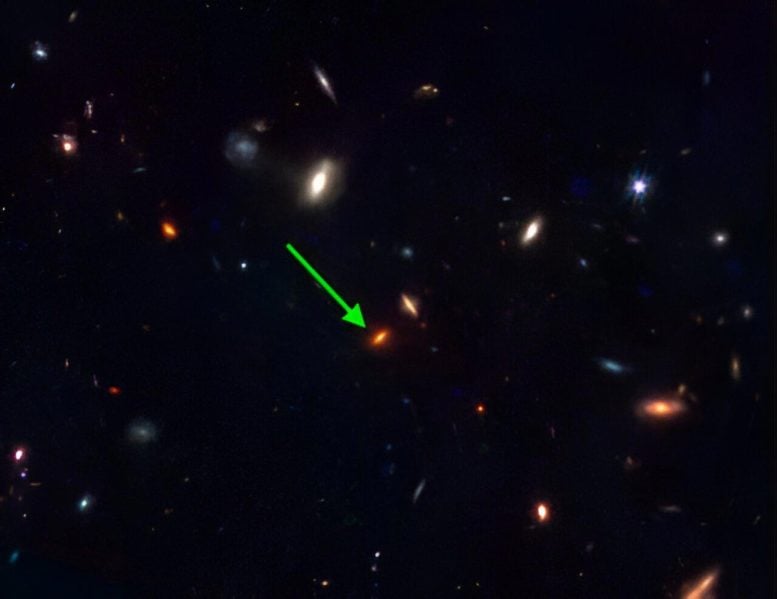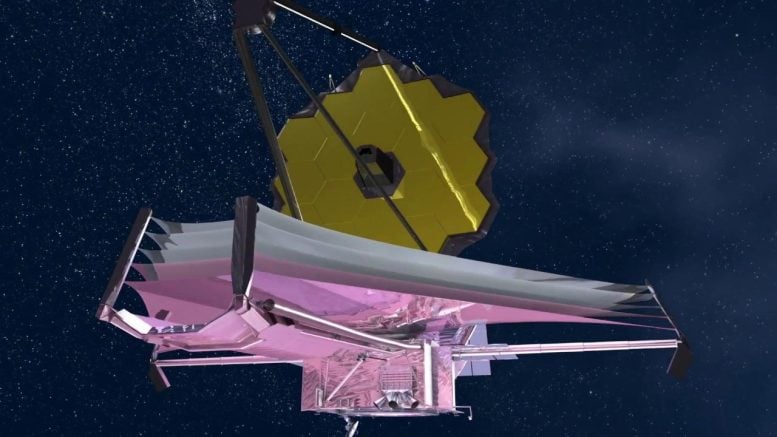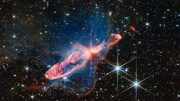
JWST-7329: a rare massive galaxy that formed very early in the Universe. This James Webb Space Telescope NIRCAM image shows a red disk galaxy but with images alone, it is hard to distinguish from other objects. Spectral analysis of its light with JWST revealed its anomalous nature – it formed around 13 billion years ago even though it contains ~4x more mass in stars than our Milky Way does today. Credit: James Webb Space Telescope
- Our understanding of how galaxies form and the nature of dark matter could be completely upended
- A paper published in Nature details findings using new data from the James Webb Space Telescope
- Distinguished Professor Karl Glazebrook led the study and the international team
Our understanding of how galaxies form and the nature of dark matter could be completely upended, after new observations of a stellar population bigger than the Milky Way from more than 11 billion years ago that should not exist.
A paper published in Nature details findings using new data from the James Webb Space Telescope (JWST). The results find that a massive galaxy in the early universe – observed 11.5 billion years ago (a cosmic redshift of 3.2) – has an extremely old population of stars formed much earlier – 1.5 billion years earlier in time (a redshift of around 11). The observation upends current modeling, as not enough dark matter has built up in sufficient concentrations to seed their formation.
Swinburne University of Technology’s Distinguished Professor Karl Glazebrook led the study and the international team that used the JWST for spectroscopic observations of this massive quiescent galaxy.
“We’ve been chasing this particular galaxy for seven years and spent hours observing it with the two largest telescopes on earth to figure out how old it was. But it was too red and too faint, and we couldn’t measure it. In the end, we had to go off the Earth and use the JWST to confirm its nature.”

NASA’s James Webb Space Telescope is the successor to the Hubble Space Telescope, the most powerful infrared science observatory ever to be sent into space. From its orbit nearly a million miles from Earth, Webb studies some of the most distant objects in the universe. Credit: NASA
The formation of galaxies is a fundamental paradigm underpinning modern astrophysics and predicts a strong decline in the number of massive galaxies in early cosmic times. Extremely massive quiescent galaxies have now been observed as early as one to two billion years after the Big Bang which challenges previous theoretical models.
Distinguished Professor Glazebrook worked with leading researchers all over the world, including Dr. Themiya Nanayakkara, Dr. Lalitwadee Kawinwanichakij, Dr. Colin Jacobs, Dr. Harry Chittenden, Associate Professor Glenn G Kacprzak and Associate Professor Ivo Labbe from Swinburne’s Centre for Astrophysics and Supercomputing.
“This was very much a team effort, from the infrared sky surveys we started in 2010 that led to us identifying this galaxy as unusual, to our many hours on the Keck and Very Large Telescope where we tried, but failed to confirm it, until finally the last year where we spent enormous effort figuring out how to process the JWST data and analyze this spectrum.”
Dr. Themiya Nanayakkara, who led the spectral analysis of the JWST data, says, “We are now going beyond what was possible to confirm the oldest massive quiescent monsters that exist deep in the Universe.”
“This pushes the boundaries of our current understanding of how galaxies form and evolve. The key question now is how they form so fast very early in the Universe and what mysterious mechanisms lead to stopping them from forming stars abruptly when the rest of the Universe doing so.”
Associate Professor Claudia Lagos from the University of Western Australia node of the International Centre for Radio Astronomy Research (ICRAR) was crucial in developing the theoretical modeling of the evolution of dark matter concentrations for the study.
“Galaxy formation is in large part dictated by how dark matter concentrates,” she says. “Having these extremely massive galaxies so early in the Universe is posing significant challenges to our standard model of cosmology. This is because we don’t think such massive dark matter structures as to host these massive galaxies have had time yet to form. More observations are needed to understand how common these galaxies may be and to help us understand how truly massive these galaxies are.”
Distinguished Professor Glazebrook hopes this could be a new opening for our understanding of the physics of dark matter.
“JWST has been finding increasing evidence for massive galaxies forming early in time. This result sets a new record for this phenomenon. Although it is very striking, it is only one object. But we hope to find more, and if we do this will really upset our ideas of galaxy formation.”
Reference: “A massive galaxy that formed its stars at z ~ 11” by Karl Glazebrook, Themiya Nanayakkara, Corentin Schreiber, Claudia Lagos, Lalitwadee Kawinwanichakij, Colin Jacobs, Harry Chittenden, Gabriel Brammer, Glenn G. Kacprzak, Ivo Labbe, Danilo Marchesini, Z. Cemile Marsan, Pascal A. Oesch, Casey Papovich, Rhea-Silvia Remus, Kim-Vy H. Tran, James Esdaile and Angel Chandro-Gomez, 14 February 2024, Nature.
DOI: 10.1038/s41586-024-07191-9









Sooner or later, the JWST will help astronomers discover the fact that the universe was always there and there has never been a BIG BANG, which is a reasonable theory but fake.
A reasonable theory cannot be fake. But it is not only reasonable, it is the theory that best matches the data.
These articles drive me bonkers. You’ve got a situation where red shift is now questionable (it always assumed space was mostly empty as any significant amount of dust or other matter between us and the object being viewed could be dimmed by that dust and therefore give a FALSE reading (older than it actually is).
Meanwhile, you’ve got people talking about galaxy formation in terms of “dark matter” and they’re confused why the newly observed data keeps contradicting theory. The problem is that Dark Matter itself is nothing more than a mathematical fudge to explain why our current theories appear to be WRONG!
It’s error built upon error,level after level until we’re so far off the map, that eventually nothing will make sense. Maybe then and only then will we finally admit not only is Dark Matter and Dark Energy sad mathematical attempts to fit square pegs into round holes, but the entire theory of the Big Bang is looking more and more to be flat out wrong!!!
Big Bang Theory is clinched on the notion of our Red Shift measurements being correct and almost everything is moving away from each other and even accelerating (mow we “need” Dark Energy to explain the acceleration). The problem is also the answer but it takes ditching our hubris and admitting Red Shift is fundamentally flawed! Everything in our current model is based on it! It’s the linchpin. The answer is if you finally admit you have incorrect red shift readings, things like the universe accelerating away from itself just magically disappear!
It’s looking more and more we have a state state universe (possibly a few bunched up against each other that can set off periodic edge interactions that might behave a bit like small scale mini-bangs) with black holes acting as recycling centers (turning matter back to more energetic forms and spreading it across the universe to eventually “coalesce” over billions of years). Parts spring up, are destroyed and new parts firm again, possibly in the space on the inside of a black hole itself (pocket universes) and those do the same creating what I liken to the “Swiss Cheese Multiverse”. The cheese melts and forms new holes, but never really goes anywhere.
Luckily your type of “I don’t understand what this is, but I have an opinion that rejects what we see” comments do not drive people bonkers despite having a century history of being wrong on modern cosmology. They mostly elicit no more than yawns and attempts to point to the science.
Space expansion is at the center of current cosmology. “The expansion of the universe is parametrized by a dimensionless scale factor a. Also known as the cosmic scale factor or sometimes the Robertson Walker scale factor, this is a key parameter of the Friedmann equations.” [“Scale factor (cosmology)”, Wikipedia] It describes increasing distances, not movements (velocities). And it is based on much more than cosmological redshift of light traveling through expanding space, dark matter as observed by tens of independent methods is one example of correctness evidence. [“Dark matter#Observational evidence”, Wikipedia]
Neither steady state theories (“state state universe”?) or cyclic theories (“recycling centers”?) can describe what we see, like Lambda-Cold Dark Matter cosmology can. That is why it is favored by the experts, the scientists.
I’m not sure what you are trying to say in the first part, but if your opinion is proposing the rejected historical “tired light” dust explanation that instigator Zwicky himself knew was obviously wrong a century ago, it is observationally wrong. In cosmological redshift photon wavepackets simply gets stretched – shifts to longer wavelengths and less energy – by traveling through space that stretch according to the scale factor increase. But in “tired light” all sorts of thing we don’t see should happen:
“The concept was first proposed in 1929 by Fritz Zwicky, who suggested that if photons lost energy over time through collisions with other particles in a regular way, the more distant objects would appear redder than more nearby ones.
Zwicky acknowledged that any sort of scattering of light would blur the images of distant objects more than what is seen. Additionally, the surface brightness of galaxies evolving with time, time dilation of cosmological sources, and a thermal spectrum of the cosmic microwave background have been observed—these effects should not be present if the cosmological redshift was due to any tired light scattering mechanism.” [Wikipedia]
I’m sure we can all forgive the first two commentators for their obvious lack of understanding. Red shift is real. Inflation (modern big bang theory) probably happened. Scientific development requires that we modify our theoretical framework as access to better and more accurate information becomes available. That doesn’t mean that good theories are wrong, just that they need some adjustments at times. Opinions are not the same as data.
The Big Bang Theory and claims about the “age” of the universe both need revising. More and more evidence is being found that galaxies evolved much earlier than believed. But cosmologists also don’t want to tackle another problem. Where did all this matter come from in the first place?
It seems you did not read “Not Applicable”‘s comment since it is applicable to you too.
As an example of scientific development which is on point here, my first comment mentions two new models explaining why we may see that galaxies evolved much earlier than believed. Another nearby example would be that until 2015 cosmological models produced 100 times more stars than is observed. A factor 10 was later recognized as being due to observational bias (seeing star forming regions better through the dust) and the other factor 10 was due to insufficient modeling of star formation (see the Starforge model that licked that problem).
As an example of that cosmologists have tackled the problem of matter formation since a century ago is the “Big Bang” cosmologies themselves. Initially the matter was considered being present from the start, since pre-relativity matter was not known to be a form of convertible energy (converted in fusion, say). But with the discovery of inflation it was recognized that (radiation and) matter is produced by the end of the inflation era releasing the energy that heats the hot big bang era of the early “big bang” LCDM universe. [“Scale factor (cosmology)”, Wikipedia]
Specifically it is the energy density fluctuations during inflation that is converted to matter density and momentum fluctuations that show up in both the cosmic background and in the cosmic web of gas and galaxies.
Currently the South Polar BICEP/Keck observatories gives the best general relativistic universe inflation model as the 0 K cold vacuum of a Higgs like scalar quantum inflation field. Then those fluctuations are recognizable as quantum fluctuations that sum to zero energy, and the energy release as the potential energy released as the inflation field collapses during the end phase transition. Since the total energy of a flat space universe is zero at all times, this is compatible with that a general relativistic universe has nothing to exchange energy with, there is no ‘outside’. This shows that like matter energy all its energies are merely transformed as space expands, and that there is likely no “first place” for energy. Energy is merely the ability to do work, the universe has always had that ability in regards itself.
So the “egg” (energy) existed before the “chicken” (matter)?
I forgot: The age of the universe since the hot big bang era is one of the *successes* of LCDM cosmology.
Before then the ages weren’t consistent with, say, some star clusters older than estimates of the universe age. The discovery of dark energy changed that and give rise to the first self consistent cosmology we have (LCDM).
As the researchers themselves note, thus far it is a massive size oddity, not a significant number of galaxies to declare a discovery from. But meanwhile there are starting to pile up models for early galaxy formation, which JWST *has* discovered.
One example is the influence of dark matter before star formation rates accelerates. “An international team of astronomers led by UCLA’s Smadar Naoz is doing simulations of early galaxy formation. Their computer programs track the circumstances of galactic births not long after the Big Bang. These “hot off the press” computer models include some new wrinkles. They take into account previously neglected interactions between dark matter and the primordial “stuff” of the Universe. That would be hydrogen and helium gas. The result of the simulations: tiny, bright galaxies that formed more quickly than in computer models that didn’t include those motions.” [Unievrse Today]
Another is the influence of early Pop III stars themselves. “Stars can only form from cold, dense gas. When gas is too hot, it simply isn’t dense enough to collapse into protostellar cores. The researchers found that when Pop III stars exploded as supernovae, they produced metals and spread them into the surrounding gas. The metals cooled the star-forming gas quickly, leading to faster formation of more stars. “Our findings indicate that SNRs from a top-heavy Pop III IMF produce more metals, leading to more efficient gas cooling and earlier Pop II star formation in the first galaxies.”” [Universe Today]
The galaxy in question should not be viewed as simply an “oddity”, massive as it is. Astronomers have found galaxies that were more evolved than they should be at that epoch. Revising a theory does not mean dispensing with it, the filament-like nature of galaxy formation and other observational effects does suggest a violent, inflationary universe. But all these “fudge” factors that are constantly introduced to explain away observations that don’t fit theory make me question the absolutist dogma (and tone) that you express.
Apparently Einstein was prevented from publicly commenting about dark matter for decades after Zwicky discovered the effect (pathetic excuse: Zwicky was a mean guy), but now Joe Sixpack global savior-cop taxpayer can’t go a week without hearing about it. MOND is touted as some sort of gravitational DM effect eraser, but it can’t erase lensing effects attributed to DM, and here’s the kicker: like plasma universe quackery, no not one MOND supporter wants to talk about that. Simple reason for all that chicanery, as well as the flacks online everywhere supporting it, is that it’s the only thing keeping overblown overpaid General Relativity talking head spook egos from disappearing themselves.
“the filament-like nature of galaxy formation and other observational effects does suggest a violent, inflationary universe”
Oh please. Filaments and the BB can both be easily explained using focus enhancement in cooled matter gravitational flows, in correctly quantized gravity, an idea the usual spooks pretend cannot possibly exist, due to ego blockage. The other “effects” so proudly glossed over there are in all likelihood merely redshift plus handwaving.
Simple things like having no clue how bright a galaxy should be in every situation allow the dark matter spooks to pretend it’s not so cold and so not always shadowing real matter as if a simple damped sinusoid rolloff convolution is the sort of aura the pinheads need to use instead of a simple inverse-sqare rolloff they rely upon now.
I need to go back to the beginning and read all this again!
Ron Budd, save yourself the trouble my friend. The article itself is fine, but I would stop there. The pompous know-it-alls who indulge in their feces throwing rants and tirades aren’t worth 2 seconds of your time.
You people have all missed the point.you are all getting confused about the universe and space. The universe is In space not the other way round. As soon as you realise that you will understand that there was no beginning and there is no end. So no matter how powerful you make the telescopes you will always find more distant galaxies.
I understand the story:)
James Webb is just seeing things 🤣!